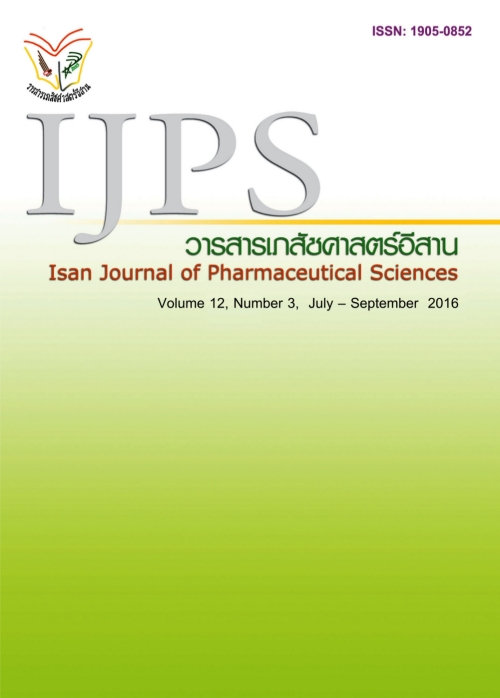Bioactivities of Goat Placenta hydrolysates
Main Article Content
Abstract
Introduction: Goat placenta is a rich source of proteins and amino acids. It has been reported that low molecular weights of short chain proteins and peptides might possess various bioactivities. Objectives: To investigate some bioactivities of proteins/peptide hydrolysates by papain enzyme. Methods: determination the characteristics of the goat placenta hydrolysates including total protein by Bradford protein assay, molecular weight by Tricine-Sodium Dodecyl Sulfate Polyacrylamide Gel Electrophoresis (Tricine-SDS PAGE) and investigation of antioxidant activities e.g. Free radical scavenging (DPPH), Inhibition of Linoleic Acid Oxidation and Ferric Reducing Power as well as anti-mushroom tyrosinase activity. Results: the % yield of the hydrolysates obtained from goat placenta was 18.31±0.42%. The total protein equivalent to bovine serum albumin was 0.075±0.003 mg/ml. The majority of obtained hydrolysates contained proteins and peptides at a molecular weight of approximately 30 kDa. Antioxidant activities of the hydrolysates were as follows; Free radical scavenging of the hydrolysates at a concentration of 6.25 mg/ml was significantly greater than that of vitamin C at 0.156 mg/ml and was not significantly different from vitamin E acetate at 83.5 mg/ml but less than that of Trolox at 0.156 mg/ml. Ferric Reducing Power of the hydrolysates at 1.5 mg/ml was equivalent to 15.74 mM Trolox which was less than 0.3 mg/ml of vitamin C. Lipid peroxidation inhibition of the hydrolysates at 1 mg/ml was 84.94% which was not significantly different from that of BHT, Trolox at 0.1 mg/ml and GSH at 1 mg/ml. The hydrolysates at 41.67 mg/ml inhibited 59.11% of mushroom tyrosinase activity. Conclusion: goat placenta proteins/peptide hydrolysates possessed antioxidant activities and anti-tyrosinase activity.
Article Details
In the case that some parts are used by others The author must Confirm that obtaining permission to use some of the original authors. And must attach evidence That the permission has been included
References
Ajibola, C. F., Fashakin, J. B., Fagbemi, T. N., &Aluko, R. E. (2011). Effect of peptide size on antioxidant properties of African yam bean seed (Sphenostylisstenocarpa) protein hydrolysate fractions.International Journal of Molecular Sciences, 12(10), 6685–6702.
Bradford, M. M. (1976). A rapid and sensitive method for the quantitation of microgram quantities of protein utilizing the principle of protein-dye binding.Analytical Biochemistry, 72(1), 248–254.
Frister, H., Meisel, H., &Schlimme, E. (1988). OPA method modified by use of N,N-dimethyl-2-mercaptoethylammonium chloride as thiol component. Fresenius’ ZeitschriftFrAnalytischeChemie, 330(7), 631–633. http://doi.org/10.1007/BF00473782
Khunkitti, W., Veerapan, P., &Hahnvajanawong, C. (2012). In vitro bioactivities of clove buds oil (Eugenia caryophyllata) and its effect on dermal fibroblast.Int J Pharm PharmSci, 4(Suppl 3), 556–560.
Kim, S.-Y., Je, J.-Y., & Kim, S.-K. (2007). Purification and characterization of antioxidant peptide from hoki (Johniusbelengerii) frame protein by gastrointestinal digestion. The Journal of Nutritional Biochemistry, 18(1), 31–38.
Langmaier, F., Mladek, M., Kolomaznik, K., &Sukop, S. (2001). Collagenous hydrolysates from untraditional sources of proteins.International Journal of Cosmetic Science, 23(4), 193–199.
Liu, C., Peng, D., Yang, J., Li, Y., & Li, J. (2010). Anti-oxidative and anti-aging activities of collagen hydrolysate. In III International Conference OnBiomedial Engineering And Informatics (BMEI) (pp. 1981–84). Retrieved from http://ieeexplore.ieee.org/xpls/abs_all.jsp?arnumber=5639440
Masaki, H. (2010). Role of antioxidants in the skin: Anti-aging effects. Journal of Dermatological Science, 58(2), 85–90. http://doi.org/10.1016/j.jdermsci.2010.03.003
Mendis, E., Rajapakse, N., Byun, H.-G., & Kim, S.-K. (2005). Investigation of jumbo squid (Dosidicusgigas) skin gelatin peptides for their in vitro antioxidant effects.Life Sciences, 77(17), 2166–2178.
Nakchum, L., & Kim, S. M. (2016). Preparation of squid skin collagen hydrolysate as an antihyaluronidase, antityrosinase, and antioxidant agent.Preparative Biochemistry and Biotechnology, 46(2), 123–130. http://doi.org/10.1080/10826068.2014.995808
Saiga, A., Tanabe, S., & Nishimura, T. (2003). Antioxidant Activity of Peptides Obtained from Porcine Myofibrillar Proteins by Protease Treatment. Journal of Agricultural and Food Chemistry, 51(12), 3661–3667. http://doi.org/10.1021/jf021156g
Sarmadi, B. H., & Ismail, A. (2010). Antioxidative peptides from food proteins: a review. Peptides, 31(10), 1949–1956.
Schurink, M., van Berkel, W. J. H., Wichers, H. J., &Boeriu, C. G. (2007). Novel peptides with tyrosinase inhibitory activity.Peptides, 28(3), 485–495. http://doi.org/10.1016/j.peptides. 2006.11.023
Teng, D., Fang, Y., Song, X., &Gao, Y. (2011). Optimization of enzymatic hydrolysis parameters for antioxidant capacity of peptide from goat placenta.Food and Bioproducts Processing, 89(3), 202–208.
Tricine-SDS-PAGE : Article : Nature Protocols. (2006). Nat. Protocols, 1(1), 16–22. http://doi.org/10.1038/nprot.2006.4
Veerapan, P. (2011). In VitroAntioxidant Activities of Essential Oils. IJPS, 7(3), 30–38.
Wong, S. P., Leong, L. P., &Koh, J. H. W. (2006). Antioxidant activities of aqueous extracts of selected plants. Food Chemistry, 99(4), 775–783.
Zhuang, Y., Zhao, X., & Li, B. (2009). Optimization of antioxidant activity by response surface methodology in hydrolysates of jellyfish (Rhopilemaesculentum) umbrella collagen. Journal of Zhejiang University SCIENCE B, 10(8), 572–579. http://doi.org/10.1631/jzus.B0920081

